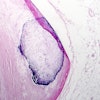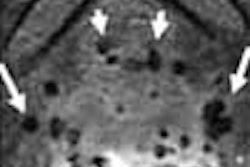A technical study by radiologists in Turin, Italy, found that virtual colonoscopy takes a little longer to perform than conventional colonoscopy. But the virtual exam is easier to perform successfully, they said, and offers more complete visualization of the colon.
Gauging VC's technical performance assessment was a secondary goal of a randomized prospective study of 90 asymptomatic subjects, said Dr. Teresa Gallo from the University of Turin and the Institute for Cancer and Treatment.
Gallo discussed the study in a presentation at the 2004 European Congress of Radiology in Vienna. All of the subjects were between 40 and 65 years of age, asymptomatic, and first-degree relatives of patients with colorectal cancer diagnosed before 60 years of age.
"We identified 258 cases...(of which) 68 were randomly selected to undergo same-day CT colonography and conventional colonography," Gallo said. "For these 68 patients we assessed mean time, including time spent by the patients from entering to leaving the (virtual colonoscopy) and conventional colonoscopy rooms, and the time spent for image processing and interpretation, the overall time for 2D reading with 3D for problem-solving."
The study also gauged the percentage of the colonic mucosa visualized in each segment of the colon, in both prone and supine positions (except for prone-only imaging in one patient), the medication required for both exams, and finally the side effects of the two screening methods.
All patients underwent purgative bowel cleansing with a polyethylene glycol preparation. Following manual room-air insufflation and intravenous administration of hyocine methylbromide (holopon) as an antispasmodic agent, non-contrast CT of the abdomen was completed in 67/68 (98.5%) of patients using a low-dose multidetector-row CT protocol, reconstructed in 1.25-mm slices. Imaging was followed by conventional colonoscopy, which reached the cecum successfully in 62 (91%) of the 68 patients.
The data were compiled from the use of two scanners, a single-detector machine before June 2003 (120 kVp, 120 mAs, 5-mm collimation, pitch 2, 1 sec. rotation), and a 16-detector scanner thereafter (1.25-mm collimation, 120 kVp, 80 mAs, 1.375 pitch, 0.6 sec. rotation), both from GE Healthcare of Waukesha, WI. Studies were interpreted on a GE Advantage Windows version 4.2 workstation, using primary 2D reading and 3D problem-solving.
"The results regarding the time-test duration showed that conventional colonoscopy was faster than CTC, and the mean time duration was 16 ± 4 minutes versus 24 ± 11 minutes," (p<0.001) Gallo said, adding that in VC most of the time was spent on interpretation.
Reading 2D axial images first with 3D problem-solving second was faster than doing it the other way around (12 ± 5 minutes for 2D first versus 20 ± 7 minutes for 3D first) she said, "but resulted in a lower polyp detection rate: 11 versus 14, although these three polyps (missed in primary 2D) were less than 10 mm in diameter."
Visualization of greater than 50% of the mucosa was achieved in 7% (conventional colonoscopy, CS) and 4% (VC) in the ascending colon, 4% (CS) versus 1% (VC) in the transverse colon, 4% (CS) versus 0% (VC) in the region that included the descending colon and procto-sigmoid tract.
Moreover, the researchers found that visualization of more than 80% of the colonic mucosa was achieved in 83% of cases in the ascending colon (versus 56% of cases in CS), in 94% of cases in the transverse colon (versus 67% of cases in CS), in 97% of cases in the descending colon (versus 69% of cases in CS) and 88% of cases in the procto-sigmoid tract (versus 72% of cases in CS) (p<0.02).
While the antispasmodic was administered in 100% of VC patients, sedation was used in 47% of colonoscopy patients, with no side effects reported in the study.
Screening with (virtual colonoscopy) can be successful in virtually all subjects, whereas conventional colonocopy fails in 8% of cases," Gallo said. "Both procedures are safe. Mucosal visualization is better achieved by (VC), although performing and reading (VC) takes more time than conventional colonoscopy. Reading 3D images first may yield more true-positive polyps than reading 2D first."
The group is currently working on a new study to evaluate the accuracy of virtual colonoscopy in subjects at increased risk of colorectal carcinoma, principal investigator Dr. Daniele Regge told AuntMinnie.com in a follow-up e-mail.
"The study is ongoing and we have now data on 74 patients," Regge wrote, adding that double-read conventional colonoscopy performed the same day is being used as a reference standard. The results so far show sensitivity of 75% for polyps 10 mm and larger, and 61.5% for polyps 5-9 mm. The positive predictive value for both size categories was 100%; the negative predictive value was 88.6% for polyps 5-9 mm and 95.1% for polyps 10 mm and larger.
By Eric BarnesAuntMinnie.com staff writer
June 1, 2004
Related Reading
Tailor insufflation technique to the patient, says VC researcher, January 30, 2004
Jury deadlocks on use of Buscopan in virtual colonoscopy, September 18, 2003
Ultralow-dose virtual colonoscopy shows high sensitivity. April 8, 2003
Electronic CO2 insufflation beats air in virtual colonoscopy, March 12, 2003
Workflow issues key in virtual colonoscopy, January 15, 2003
Virtual colonoscopy: 2-D vs. 3-D primary read, June 3, 2002
Copyright © 2004 AuntMinnie.com




















